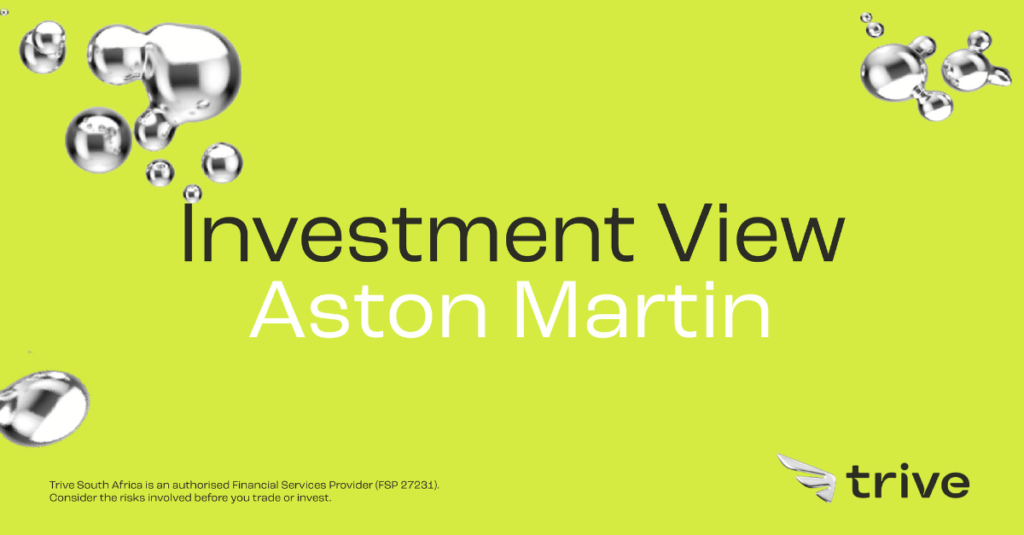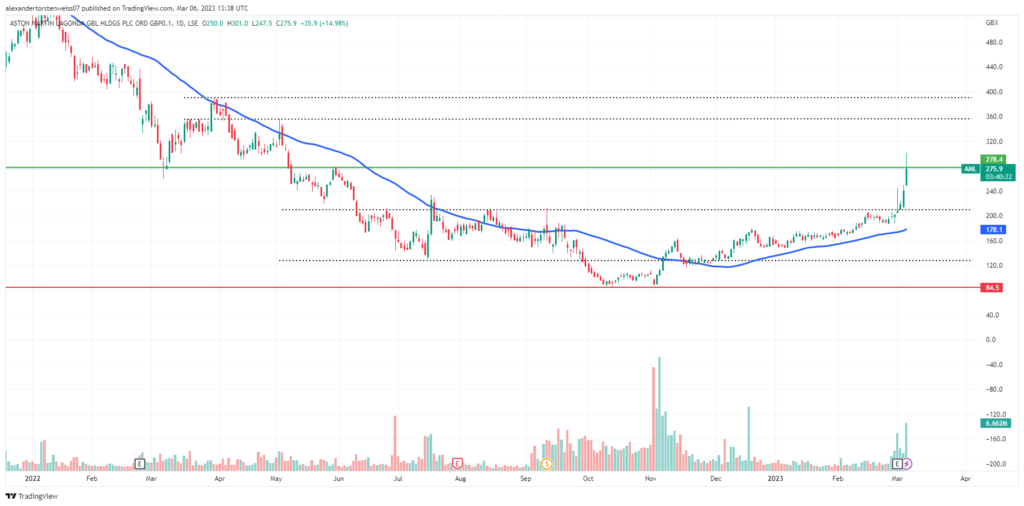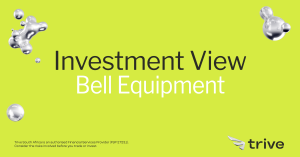
With the first race of the much-anticipated 2023 Formula 1 season already behind us, stakeholders, investors, and teams finally have an idea of the pecking order. Still, much like the financial markets, nothing is set in stone. Despite Ferrari’s Charles Le Clerc having a race to forget in Bahrain and Mercedes describing the Grand Prix as one of their “worst days in racing,” Aston Martin emerged as the predominant dark horse, with Fernando Alonso taking a well-deserved third place, hailing an “unreal” start to the season.
Aston Martin Lagonda Global Holdings Plc. (LON: AML) has seen its share price surge since the beginning of March. Given the Formula 1 team’s stellar start to the 2023 campaign, stakeholders are understandably excited about what the future has in store for the luxury sports car manufacturer.
Opening at £1.98 on Monday, the 27th of February 2023, the price action soared more than 20% over the week to close at £2.40 flat on Friday, the 3rd of March. Heading into the first Grand Prix of the most anticipated season in the sport’s history, Aston Martin’s share price closed at its highest level since June 2022, with the British luxury carmaker forecasting a strong 2023 financial year.
Technical Analysis
Looking at the 1D price chart of Aston Martin Lagonda Global Holdings Plc. (LON: AML), the price action has been consolidating sideways for the last three months, with the primary resistance and support levels firmly at £2.10 and £1.28, respectively (black dotted lines).
However, the share price gapped higher to open at £2.50 on Monday, the 6th of March, breaking out of the consolidation phase. With the share price surging and the Formula 1 team racing onward to a podium finish, will 2023 deliver further growth for Aston Martin shareholders as the giant automobile manufacturer forecasts a robust financial year?
For the bull case, a long-term investment opportunity could exist if the price action pushes above the £2.78 resistance level (green line), which could be the first resistance point in the price for the bulls. Suppose the price breaches the significant resistance level at £2.78 per share. In that case, the possibility exists that the price could reach £3.57 (black dotted line), a share level towards the primary price resistance of £3.91.
For the bear case, the price action can retract and decline towards the £1.28 support level. If that support level does not hold, the bears could see the share price fall towards the primary support level of £0.84 (red line).

Fundamental Analysis
2022 marked a rather challenging year for Aston Martin Lagonda Global Holdings Plc. (LON: AML). The luxury carmaker saw its latest annual pre-tax losses widen against the backdrop of a “weakening U.K. currency.” Seeing that the Formula 1 team had a troublesome 2022 campaign, it is no surprise that stakeholders are hoping for a promising 2023, both on the racetrack and in the stock market.
The British carmaker reported that year-on-year pre-tax losses “more than doubled to £495 million in 2022, from £213.8 million in 2021” as profitability was perversely affected by a weakening GBP throughout last year. In the 2022 financial year, adjusted operating losses increased by nearly 60% to £118 million from £74 million in 2021. A turbulent macroeconomic environment proved troublesome for the luxury carmaker in 2022, and action on the racetrack was not much better during last year’s Formula 1 campaign, as Aston Martin only managed seventh place in the constructor’s championship. Closing above £5.00 per share on the final trading day of 2021, Aston Martin saw its share price plummet to £1.54 at market close on the 30th of December 2022.
Fast forward to 2023, and matters appear much more promising for Aston Martin, with Executive Chairman Lawrence Stroll reporting, “The future is fantastic, the cars are coming, fundamentals of the business are extremely strong, and demand has never been stronger.” With an order book that has “never been [better],” Lawrence Stroll also reiterated the company’s target to become “sustainably free cash flow positive from 2024,” a statement that has investors buzzing with excitement.
Lawrence Stroll has repeatedly emphasised the group’s target to “deliver around £2 billion of revenue and £500 million of adjusted EBITDA by 2024/25” since he became Executive Chairman of Aston Martin Lagonda in April 2020. Recently, Stroll stated that “we are on track to meet these financial targets”, albeit with lower volumes than he had initially envisaged. Stroll’s optimistic guide for 2023 has seen positive sentiment enter the market as Aston Martin’s share price surges higher. Aston Martin’s Formula 1 team appears to be following suit, displaying a heroic performance at the season-opening Grand Prix in Bahrain as two-time world champion Fernando Alonso took home a well-deserved podium finish. Aston Martin found themselves with the “second best car in Bahrain, just behind Red Bull.”
Summary
Closing at £2.40 per share on Friday, the 3rd of March 2023, Aston Martin has seen its share price race on to open at £2.50 on Monday, the 6th of March, as positive sentiment carries the share price higher following Lawrence Stroll’s optimistic guide for 2023.
Depending on how well the market reacts to Stroll’s guidance for a robust performance in 2023, the possibility could exist for a long above £2.78 to the next significant resistance at £3.57. The potential also exists for the price action to test the resistance at £2.78 and retract toward lower support levels.
A solid start to the new Formula 1 campaign for Aston Martin, a surging share price and an optimistic guide for the 2023 financial year have bullish investors buzzing with excitement. Still, much like the financial markets, nothing is set in stone. Investors, F1 fans, and market participants will have to wait and see how Aston Martin performs business-wise and on the racetrack.
Sources: Bloomberg, CNBC, Formula 1, The Independent, Trading View
Disclaimer: Trive South Africa (Pty) Ltd, Registration number 2005/011130/07, and an Authorised Financial Services Provider in terms of the Financial Advisory and Intermediary Services Act 2002 (FSP No. 27231). Any analysis/data/opinion contained herein are for informational purposes only and should not be considered advice or a recommendation to invest in any security. The content herein was created using proprietary strategies based on parameters that may include price, time, economic events, liquidity, risk, and macro and cyclical analysis. Securities involve a degree of risk and are volatile instruments. Market and economic conditions are subject to sudden change, which may have a material impact on the outcome of financial instruments and may not be suitable for all investors. When trading or investing in securities or alternative products, the value of the product can increase or decrease meaning your investment can increase or decrease in value. Past performance is not an indication of future performance. Trive South Africa (Pty) Ltd, and its employees assume no liability for any loss or damage (direct, indirect, consequential, or inconsequential) that may be suffered from using or relying on the information contained herein. Please consider the risks involved before you trade or invest.




